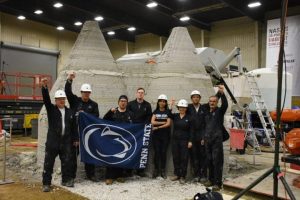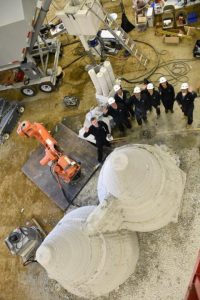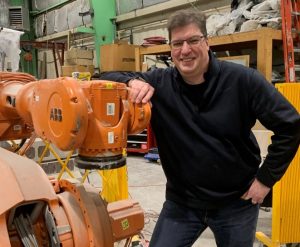By Cara Aungst

After success with the NASA 3D-printed Mars Habitat challenge, several researchers formed X-Hab 3D, an expeditionary 3D printing company.
There’s an unassuming building on a through-street of CATO Park. It was once a North American Refractories Company (NARCO) building and, if you’ve ever driven past it — chances are that you have — you’d have no idea that, inside, researchers are developing concrete formulations for testing in microgravity on the International Space Station, designing 3D-printed housing for life on Mars and solving a housing crisis in Alaska.
The Additive Construction Laboratory (AddCon Lab) is located in the cavernous back half (the “highbay”) of CITEL, where 3D-printing systems are being developed for construction, to create concrete structures that are printed rather than poured. The research effort has spanned over half a decade and the work has advanced the state-of-the-art in 3D-printed concrete.
Recently, several of the lab’s founders formed X-Hab 3D to commercialize the technology, with a focus on developing expeditionary-grade, mobile 3D concrete printers.
The printers are built to perform just about anywhere — indeed they’re “Expeditionary by Design” — and, now, the Defense Advanced Research Projects Agency (DARPA) is investing in that mission.
“With this DARPA grant, X-Hab 3D will be developing carbon-neutral material formulations for artificial reefs along coastlines,” Sven Bilén, X-Hab 3D’s systems engineering lead said. “These are not insignificant installations — the Department of Defense has 1,700 coastal facilities that are affected by the rise in sea level.”
With proprietary compounds created in partnership with Aleksandra Radlińska of Penn State’s Department of Civil and Environmental Engineering and J.P. Gevaudan in Architectural Engineering, Bilén and his team will be working aggressively on the project for the next 12 months.
“DARPA refers to this type of research as ‘DARPA Hard,’ or near impossible,” he said. “But, they get them done — innovations like the internet and GPS. We have a one-year Phase One SBIR, and, if awarded, Phase Two will add two more years.”
Printing 3D habitats for Mars, the frontiers of Alaska and under the sea
It’s a natural step for X-Hab 3D’s founders, who first joined forces in 2017 in response to a NASA Centennial Challenge. The 3D-Printed Habitat Challenge tasked teams with printing 3D habitats for living on Mars. After competing and winning several awards, the lab used the funding to further develop the team’s ideas. “It also showed us how to do this on Earth,” Bilén said.
The system is made up of expeditionary robots using specialty blends of materials, controlled with proprietary software. Because the company has developed rugged robots that can work under harsh conditions, along with a range of concrete to fit different building needs, the team can create structures quickly and efficiently. The result: the ability to build almost anywhere, from Mars, to the coastline, to Alaska.
“There’s another really important project we are working on simultaneously, along with the DARPA grant,” Bilén said. “We’re partnering with Xtreme Habitats Institute and others to battle the massive housing shortages in Alaska, with 3D-printed housing.”

AddCon Lab has worked on designing 3D-printed housing for life on Mars and, with X-Hab 3D, solving a housing crisis in Alaska.
“Innovations happen when you bring people together”
X-Hab 3D began when Bruce Kraselsky, a serial entrepreneur who became the company’s CEO, joined forces with three AddCon Lab founders, Profs. Bilén, José Duarte, and Shadi Nazarian, and Nate Watson, who was part of the lab and the NASA Challenge team as a student. Nate is vice president of engineering and product, and the principal investigator for the DARPA effort.
In addition to his work with the company, Bilén is a professor of engineering design, electrical engineering and aerospace engineering at Penn State. A Penn State alumnus, he has more than three decades of experience designing, building and fielding innovative systems for harsh and demanding environments.
X-Hab 3D is not his first foray into commercialization; it’s not even close. Over the years, he’s worked on an in-space thruster that was commercialized by a “new space” company in Silicon Valley; an “indoor GPS” system for retail stores; and “prosumer” 3D printing technology. “I like to see what I work on getting into the wild,” he said.
The innovations he’s pushed forward vary widely, but there’s a common thread that enabled all of them: collaboration.
Bilén said he strongly believes innovation happens at the intersection of disciplines.
“Innovations happen when you bring people together,” he said. “If you only do stuff in your own field, you can only go so far. It’s when you apply principles from other fields that innovation happens.”
“Think about things that you would consider really innovative,” he added. “They are typically not found in a specific industry, because it takes a whole team of people. And oftentimes, another field has already solved a problem that you are running into with your project. If you aren’t talking to them, you are never going to know that.”
“If you really want to geek out on this concept,” he continued, “I recommend looking into TRIZ, the Russian acronym for the Theory of Inventive Problem Solving, which fosters invention by looking at data on similar past projects and states that inventiveness can be learned by anyone.”
The Penn State connection: “I couldn’t be doing what I’m doing just anywhere”
Bilén said the concept of collaboration fostering innovation is lived out at Penn State:
“I couldn’t be doing what I’m doing just anywhere. Penn State does particularly well at interdisciplinary research and pulling together experts from many different fields.”
“There are reports on how cluster hiring doesn’t work, but it works here. And it’s really grown the entrepreneurial ecosystem.”
“I left Penn State with my B.S. in electrical engineering in 1991 and came back to join the faculty in 2000. I’ve been entrepreneurial since Day One. Back then, entrepreneurial activities were not supported as well, but I’ve watched Penn State make huge strides to help researchers and innovators move toward commercialization. It never works when it’s just top down, and it seldom works when it’s just bottom up — but with InventPennState, Innovation Park and resources like Ben Franklin Technology Partners, which has also just awarded startup funding to X-Hab 3D — the bottom and top are meeting. We can push, they can pull. I see things changing,” he said.
“State College is a great place for innovation,” he added. “A lot of my students in the past just wanted to leave, but now, they are excited to stay at the startups. I’m really optimistic about the future.”

Sven Bilén, X-Hab 3D’s systems engineering lead, credits Penn State’s collaborative culture for fueling the company’s growth. “Penn State does particularly well at interdisciplinary research and pulling together experts from many different fields.”
Cara Aungst writes about industry, innovation and how Happy Valley ideas change the world. She can be reached with story ideas and comments at Cara@AffinityConnection.com.






